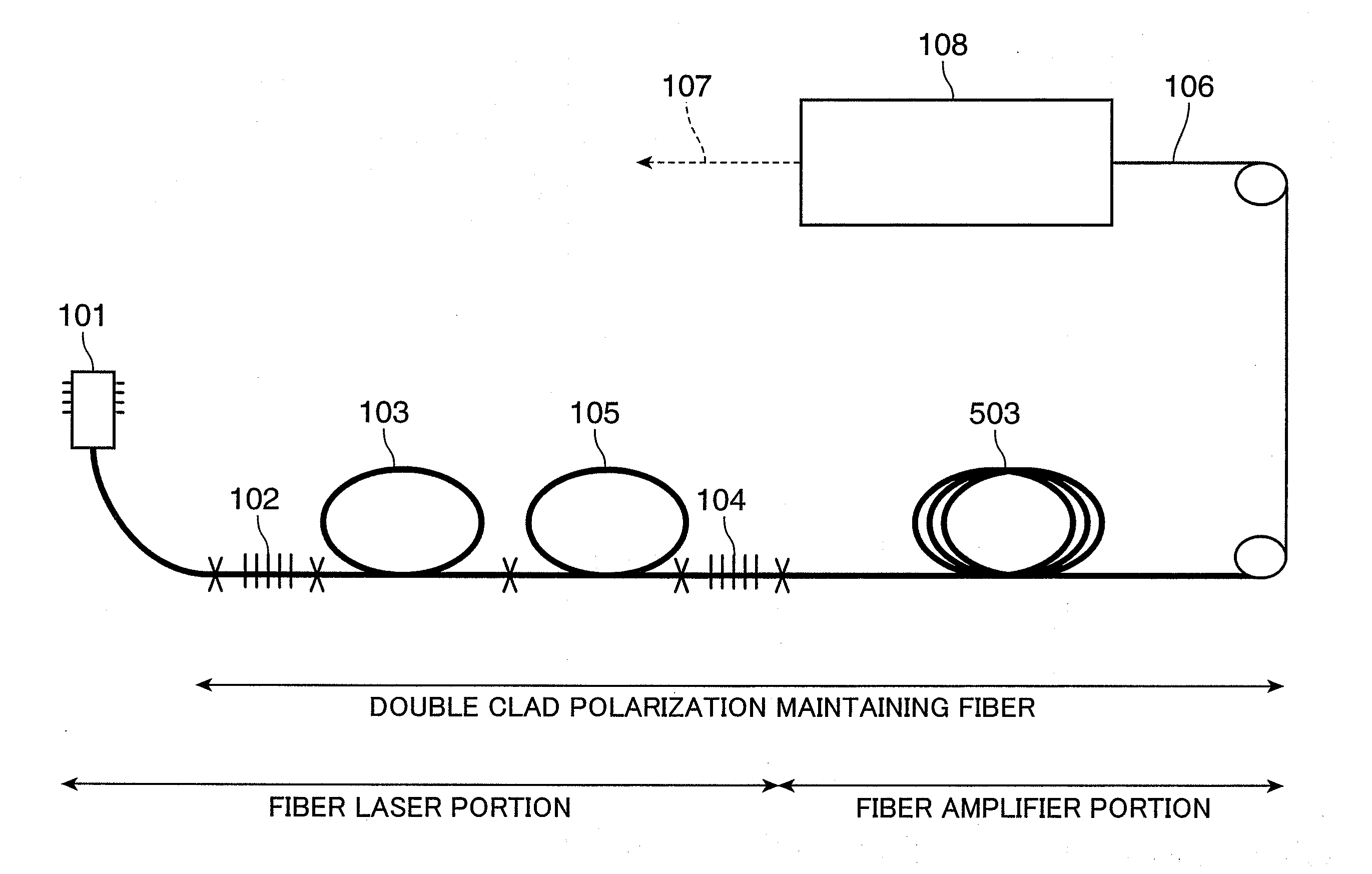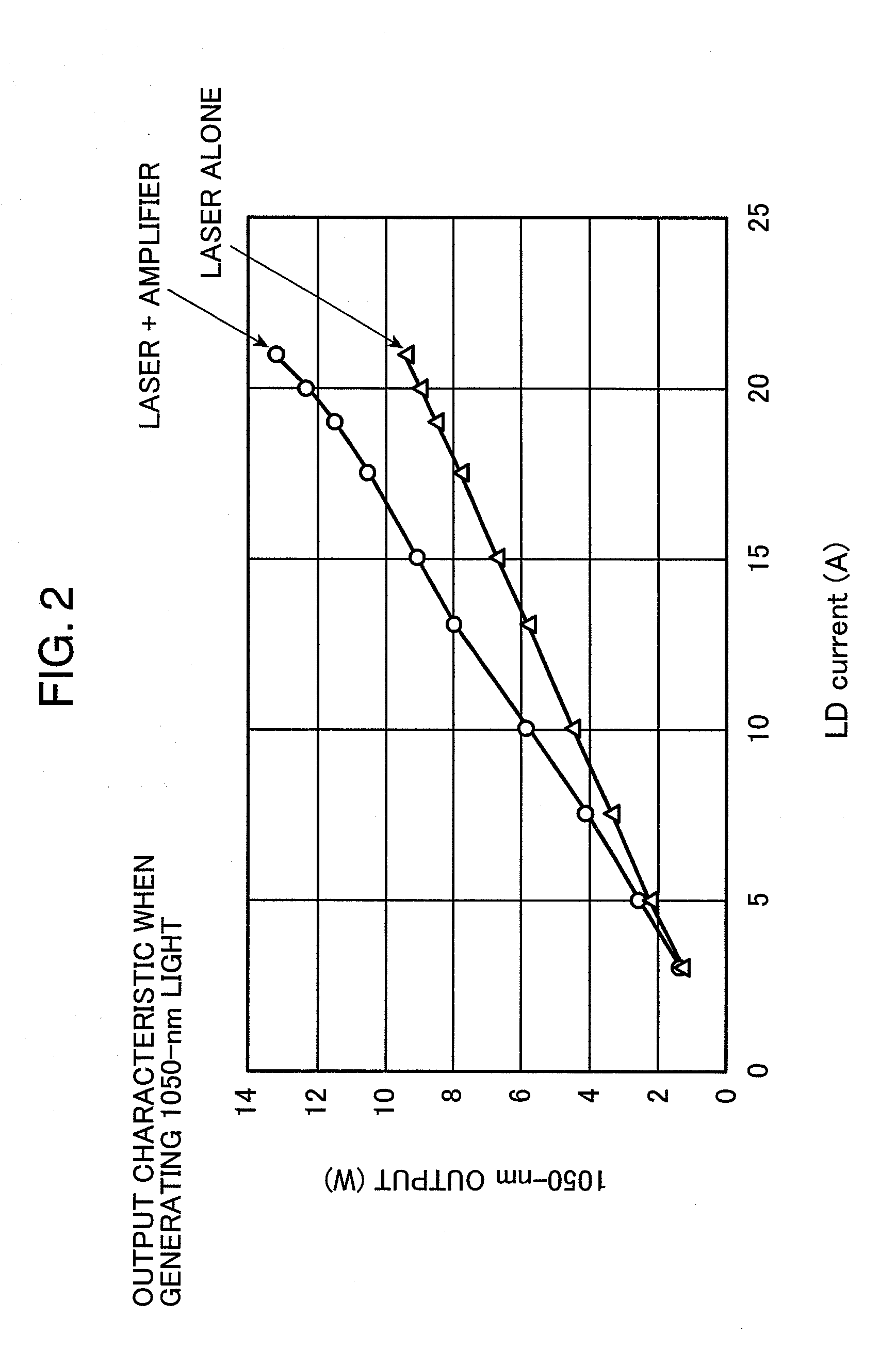Laser light source device, image display and illuminator
- Summary
- Abstract
- Description
- Claims
- Application Information
AI Technical Summary
Benefits of technology
Problems solved by technology
Method used
Image
Examples
first embodiment
[0060]A first embodiment of the invention is a case where a fiber laser and a fiber amplifier both using a polarization maintaining fiber are combined.
[0061]FIG. 1 shows the configuration of a laser light source device according to the first embodiment of the invention. Referring to FIG. 1, the laser light source device of this embodiment includes a fiber laser portion and a fiber amplifier portion. The fiber laser portion includes a pump LD 101, a fiber grating 102, an Yb-doped double clad polarization maintaining fiber 103, a fiber grating 104, and a polarizer 105. The fiber amplifier portion includes an Yb-doped double clad polarization maintaining fiber 503. Both the fiber laser portion and the fiber amplifier portion are made of a double clad polarization maintaining fiber. Signal light generated in the fiber laser portion is amplified in the fiber amplifier portion. The laser light source device of this embodiment is connected to a second-harmonic generation (SHG) module 108 v...
second embodiment
[0096]As a second embodiment of the invention, the configuration to generate light at 515 nm through the second harmonic generation from the fundamental harmonic at 1030 nm will be described. It is possible to replace a high output Ar ion laser with a laser light source device of this embodiment.
[0097]A difference of the laser light source device of this embodiment from the laser light source device of the first embodiment above is the length of the Yb-doped fiber 103 used in the fiber laser portion in FIG. 1. Hereinafter, the difference will be described. The laser light source device of this embodiment can be achieved by the same configuration as that of the laser light source device of the first embodiment above except for the length of the Yb-doped fiber 103.
[0098]When generating light at 1030 nm, the wavelength cannot be selected in the fiber grating 104 when the fiber length exceeds 3 m, and the oscillation wavelength becomes unstable. This is because a loss in the Yb-doped fi...
third embodiment
[0107]The laser light source devices described in the first embodiment and the second embodiment above are used as a display light source in a laser display (image display), a backlight light source in a liquid crystal display, or a light source in an ornament illuminator.
[0108]As an example of the use of the laser light source devices descried in the first embodiment and the second embodiment above, an example of the configuration of a laser display (image display) to which the laser light source devices are applied will be described using FIG. 5.
[0109]Laser light sources 1201a through 1201c of three colors, red (R), green (G), and blue (B), are used in the laser light source device. A GaAs semiconductor laser having the wavelength of 638 nm is used as the red laser light source 1201a and a GaN semiconductor laser having the wavelength of 465 nm is used as the blue laser light source 1201c. Also, a wavelength conversion green light source device provided with a wavelength conversio...
PUM
 Login to View More
Login to View More Abstract
Description
Claims
Application Information
 Login to View More
Login to View More - R&D
- Intellectual Property
- Life Sciences
- Materials
- Tech Scout
- Unparalleled Data Quality
- Higher Quality Content
- 60% Fewer Hallucinations
Browse by: Latest US Patents, China's latest patents, Technical Efficacy Thesaurus, Application Domain, Technology Topic, Popular Technical Reports.
© 2025 PatSnap. All rights reserved.Legal|Privacy policy|Modern Slavery Act Transparency Statement|Sitemap|About US| Contact US: help@patsnap.com



